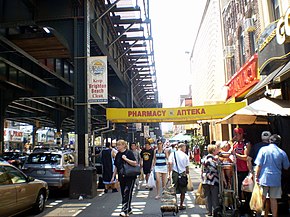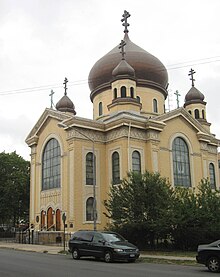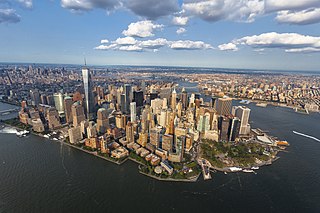
The New York metropolitan area, broadly referred to as the Tri-State area and often also called Greater New York, is the largest metropolitan area in the world by urban landmass, encompassing 4,669.0 sq mi (12,093 km2). The New York metropolitan area is one of the most populous metropolitan areas in the world and the only U.S. metropolitan area larger than twenty million residents as of the 2020 United States census. The vast metropolitan area includes New York City, the nation's most populous city, Long Island, the Mid- and Lower Hudson Valley in New York State; fourteen counties and eleven of the largest cities in New Jersey; and six of the seven largest cities in Connecticut. The phrase "Tri-State area" usually refers to New York / New Jersey / Connecticut, although an increasing number of people who work in New York City commute from Pennsylvania, particularly from the Lehigh Valley, Bucks County, and Poconos regions in eastern Pennsylvania. The New York metropolitan area is the geographic and demographic hub of the larger Northeast megalopolis.

Romanian Americans are Americans who have Romanian ancestry. According to the 2017 American Community Survey, 478,278 Americans indicated Romanian as their first or second ancestry, however other sources provide higher estimates, which are most likely more accurate, for the numbers of Romanian Americans in the contemporary United States; for example, the Romanian-American Network supplies a rough estimate of 1.2 million who are fully or partially of Romanian ethnicity. There is also a significant number of people of Romanian Jewish ancestry, estimated at about 225,000.

Brighton Beach is a neighborhood in the southern portion of the New York City borough of Brooklyn, within the greater Coney Island area along the Atlantic Ocean coastline. Brighton Beach is bounded by Coney Island proper at Ocean Parkway to the west, Manhattan Beach at Corbin Place to the east, Sheepshead Bay at the Belt Parkway to the north, and the Atlantic Ocean to the south along the beach and boardwalk.

New York City is a large and ethnically diverse metropolis. It is the largest city in the United States with a long history of international immigration. The New York region continues to be by far the leading metropolitan gateway for legal immigrants admitted into the United States. The city is the geographical and demographic center of both the Northeast megalopolis and the New York metropolitan area, the largest metropolitan area in the U.S. by both population and urban area. With over 20.1 million people in its metropolitan statistical area and 23.5 million in its combined statistical area as of 2020, New York City is one of the world's most populous megacities.

Bangladeshi Americans are Americans of Bangladeshi descent. Most Bangladeshi Americans are also Bengali Americans. Bangladeshi Americans are usually Muslims with roots in Bangladesh in which Bengali is the majority language. Since the early 1970s, Bangladeshi immigrants have arrived in significant numbers to become one of the fastest growing ethnic groups in the U.S. New York City is home to two-thirds of the Bangladeshi American population. Meanwhile, Paterson, New Jersey; Atlantic City, New Jersey are also home to notable Bangladeshi communities. Over 400,000 people leave Bangladesh with the sole goal of finding employment in other countries.

Russian Americans are Americans of full or partial Russian ancestry. The term can apply to recent Russian immigrants to the United States, as well as to those who settled in the 19th century Russian possessions in northwestern America. Russian Americans comprise the largest Eastern European and East Slavic population in the U.S., the second-largest Slavic population generally, the nineteenth-largest ancestry group overall, and the eleventh-largest from Europe.

According to the U.S. Census Bureau, as of 2023, New York was the fourth largest state in population after California, Texas, and Florida, with a population of 19,571,216, a decrease of over 600,000 people, or −3.1%, since the 2020 census. The population change between 2000–2006 includes a natural increase of 601,779 people and a decrease due to net migration of 422,481 people out of the state. Immigration from outside the United States resulted in a net increase of 820,388 people, and migration within the country produced a net loss of about 800,213.
Azerbaijani Americans are Americans of the Azerbaijani ancestry from the Republic of Azerbaijan and Iranian Azerbaijan or people possessing Azerbaijani, Iranian, and/or American citizenship. Most Azerbaijani Americans have immigrated to the United States from Azerbaijan, Iran, Germany, Georgia, Russia, Turkey and Ukraine.
Georgian Americans are Americans of full or partial Georgian ancestry. They encompass ethnic Georgians who have immigrated to the U.S. from Georgia, as well as other areas with significant Georgian populations, such as Russia.

Since its founding in 1625 by Dutch traders as New Amsterdam, New York City has been a major destination for immigrants of many nationalities who have formed ethnic enclaves, neighborhoods dominated by one ethnicity. Freed African American slaves also moved to New York City in the Great Migration and the later Second Great Migration and formed ethnic enclaves. These neighborhoods are set apart from the main city by differences such as food, goods for sale, or even language. Ethnic enclaves provide inhabitants security in work and social opportunities, but limit economic opportunities, do not encourage the development of English speaking, and keep immigrants in their own culture.
The 1990s post-Soviet aliyah began en masse in the late 1980s when the government of Mikhail Gorbachev opened the borders of the Soviet Union and allowed Jews to leave the country for Israel.
Israeli Americans are Americans who are of full or partial Israeli descent. In this category are those who are Israelis through nationality and/or citizenship. Reflecting Israel's demographics, while the vast majority of the Israeli American populace is Jewish, it is also made up of various ethnic and religious minorities; most notably the ethnic Arab minority, which includes Muslims, Christians, and the Druze, as well as the smaller non-Arab minority ethnic groups.
The Russian language is among the top fifteen most spoken languages in the United States, and is one of the most spoken Slavic and European languages in the country. Since the dissolution of the Soviet Union, many Russians have migrated to the United States and brought the language with them. Most Russian speakers in the United States today are Russian Jews. According to the 2010 United States Census the number of Russian speakers was 854,955, which made Russian the 12th most spoken language in the country.
Uzbek Americans are Americans of Uzbek descent. The community also includes those who have dual American and Uzbek citizenship.

The New York metropolitan area is home to the largest and most prominent ethnic Chinese population outside of Asia, hosting Chinese populations representing all 34 provincial-level administrative units of China. The Chinese American population of the New York City metropolitan area was an estimated 893,697 as of 2017, constituting the largest and most prominent metropolitan Asian national diaspora outside Asia. New York City itself contains by far the highest ethnic Chinese population of any individual city outside Asia, estimated at 628,763 as of 2017.

In the New York metropolitan area, Filipinos constitute one of the largest diasporas in the Western Hemisphere. By 2014 Census estimates, the New York City-Northern New Jersey-Long Island, NY-NJ-CT-PA Combined Statistical Area was home to 262,375 Filipino Americans, 221,612 (84.5%) of them uniracial Filipinos.
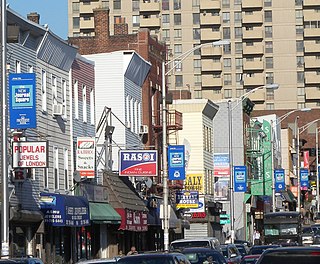
Indians in the New York City metropolitan area constitute one of the largest and fastest-growing ethnicities in the New York City metropolitan area of the United States. The New York City region is home to the largest and most prominent Indian American population among metropolitan areas by a significant margin, enumerating 711,174 uniracial individuals based on the 2013–2017 U.S. Census American Community Survey estimates. The Asian Indian population also represents the second-largest metropolitan Asian national diaspora both outside of Asia and within the New York City metropolitan area, following the also rapidly growing and hemisphere-leading population of the estimated 893,697 uniracial Chinese in the New York City metropolitan area in 2017.
Soviet Jews in America or American Soviet Jews are Jews from former Soviet Republics that have emigrated to the United States. The group consists of people that are Jewish by religion, ethnicity, culture, or nationality, that have been influenced by their collective experiences in the Soviet Union. In the 60s, there were around 2.3 million Jews in the USSR, as ethnicity was recorded in the census. Jews from the Soviet Union consisted mostly of the Ashkenazi sect, and emigrated in waves starting in the 1960s, with over 200,000 leaving in the 1970s. As of 2005, over 500,000 Jews had left Soviet Republics for the United States. American Soviet Jews are often covered by the blanket term, "Russian-speaking Jews", and are a self-selecting group, due to the barriers that people leaving the USSR had to face. Often-times, Soviet immigrants struggle with the abundance of choices that they can make in America, but after learning the language, have been shown to be as well-adjusted as other immigrant groups.
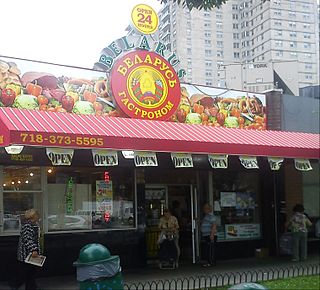
New York City includes a sizeable Belarusian American population. The New York metropolitan area has one of the largest concentrations of Belarusians in the United States. Many Belarusians live in Brighton Beach and elsewhere in South Brooklyn, along with other ex-Soviet immigrants including Russians and Ukrainians. Around 55,000 people of Belarusian descent live in the New York City metropolitan area, with estimates ranging from 50,000 to 75,000.
